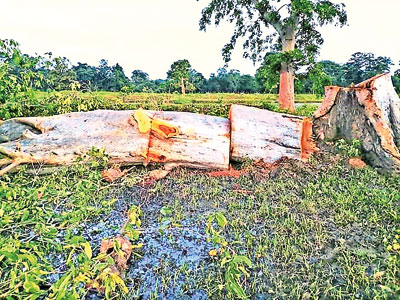News
Flood Plains Valley Protection People’s Movement fears flood gates will open
If squatters are allowed to cultivate lands inside Flood Plains National Park, it will open flood gates for people who live close to national parks in Polonnaruwa and elsewhere to claim their so-called traditional paddy fields inside national parks and disturb its fauna and flora, an environmentalist has warned.

The illegal felling of trees inside the park continues
A Flood Plains Valley Protection People’s Movement spokesman said Flood Plains, Somawathiya, Kaudulla, Minneriya, Angamedilla and Wasgamuwa National Parks formed a ring around Polonnaruwa, and illegal cultivation inside those parks would destroy them.
It would also disrupt the movement of hundreds of wild elephants and compel them to invade thousands of hectares of cultivations, rice fields or villages and intensify the human-elephant conflict, he warned.
Parakarama Samudraya United Farmer Association President Jagath Amarakeerthi said that on behalf of the villagers who were already affected by wild elephant attacks, he had made submissions before a committee, along with representatives of the claimants.
The committee appointed to make recommendations to the Wildlife Conservation Ministry to look into claims of squatters cultivating paddy inside the Flood Plains National Park, made inquiries in Polonaruwa on February 9.
Wildlife Director General M G C Sooriyabandara said the committee would hold more inquires before it made its recommendations to the Parliamentary consultative committee. “We are compiling information and would have a few more such meetings with the parties concerned,” he said.
On behalf of claimants, the squatters who lost their appeal in the High Court against the Magistrate Court order, Sri Lanka Podujana Peramuna District Organiser Mohamed Casim Abdul Samad said traditional paddy fields inside the National Park should be given back to the farmers. Those who vandalise archaeological sites and illegally fell trees inside the park should be arrested, he said.
Mr Samad said there were 218 people claiming to have cultivated about 580 acres of land inside the Park. He said that in the 1970s maps had been drawn to show these traditional paddy cultivations.
When the Wildlife Department acquired the lands for the park in 1984, those who were cultivating inside the lands were not given alternative lands. They continued to cultivate the lands until 2015. They were prevented from entering the Park only in 2019 after they lost their appeal in the High Court Mr Samad said.
However, the People’s Movement spokesperson contradicted Mr Samad’s claims. “Those 218 people who claimed to have cultivated lands inside the National Park lost the case against them, first in the Magistrate’s Court and then they lost their appeal in the High Court, as they did not have title deeds or any valid evidence.”
“These are not traditional paddy lands; majority of those who claimed they inherit traditional lands started cultivating there only after 2000, during the war,” the People’s Movement spokesman said. He added that only a few of them had illegally cultivated lands inside the Park.
He also pointed out the 1:50000 Survey Department map of the area did not depict any paddy lands inside the park.


